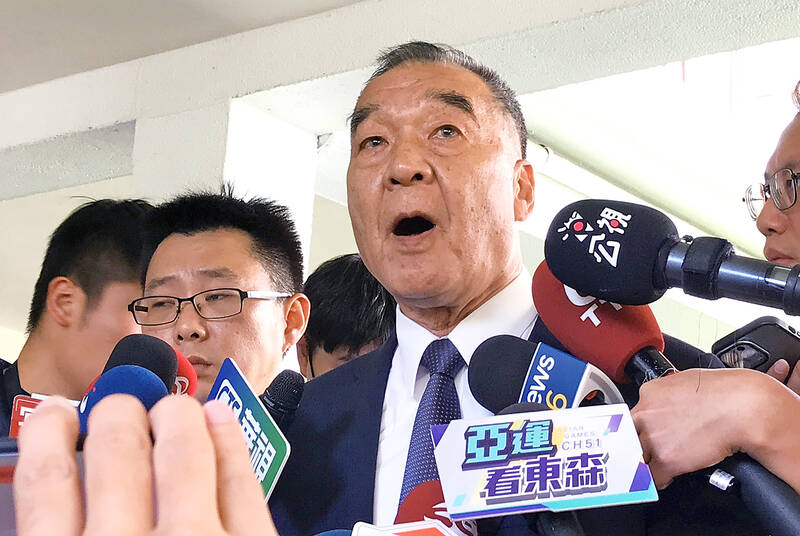Chinese movements around Taiwan were “abnormal,” Minister of National Defense Chiu Kuo-cheng (邱國正) said yesterday, flagging recent amphibious exercises in addition to drills Taipei has observed in China’s Fujian Province.
Taiwan has reported a rise in Chinese military activity over the past week as dozens of fighters, drones, bombers and other aircraft, as well as warships, have operated around the nation.
“Our initial analysis is that they are doing joint drills in September, including land, sea, air and amphibious,” Chiu told reporters at the legislature in Taipei.

Photo: Liu Hsin-de, Taipei Times
The “recent enemy situation is quite abnormal,” he said.
The comments followed a statement from the ministry on Thursday that it was keeping watch on Chinese activities near Dacheng Bay in Fujian Province.
Taiwan security sources said that China performs landing drills in the bay area.
China has not said anything about the drills around Taiwan, and its defense ministry did not respond to two requests for comment.
Chiu said releasing the information about Dacheng Bay was in line with his ministry’s principle of telling people what was happening.
China carried out landing drills in Dacheng Bay in September last year and the year before that, said Chieh Chung (揭仲), a military researcher at the National Policy Foundation think tank.
Those exercises featured civilian ships with equipment practicing “dockless unloading,” to simulate a situation in which they might need to land after port facilities are knocked out of action or destroyed, Chieh said.
However, China would be hard-pressed to carry out a frontal, amphibious invasion of Taiwan, given geographic difficulties, a senior US defense official told the US Congress on Tuesday.
Last week, China also dispatched more than 100 naval ships on regional exercises, in areas such as waters in the South China Sea and off Taiwan’s northeast coast, a regional security official said on condition of anonymity.
China traditionally performs large-scale exercises from July to September, the Ministry of National Defense has said.
Yesterday, the ministry said that it had detected 24 Chinese People’s Liberation Army (PLA) Air Force planes entering Taiwan’s air defense zone over the previous 24 hours, with at least 17 crossing the median line of the Taiwan Strait, as shown on a map it published.
Another security source told reporters, also on condition of anonymity, that China was likely seeking to wear out Taiwan’s military with constant missions so close to Taiwan, especially with longer flights along the median line than before.
“China is seeking to normalize these activities and push Taiwan into a corner,” the source said, adding that it risk a miscalculation if Chinese ships or aircraft got too close and Taiwan opened fire.
Taiwan has frequently said that it would remain calm and not escalate the situation, but that it would not allow “repeated provocations” from China, the source said.

MISINFORMATION: The generated content tends to adopt China’s official stance, such as ‘Taiwan is currently governed by the Chinese central government,’ the NSB said Five China-developed artificial intelligence (AI) language models exhibit cybersecurity risks and content biases, an inspection conducted by the National Security Bureau (NSB) showed. The five AI tools are: DeepSeek, Doubao (豆包), Yiyan (文心一言), Tongyi (通義千問) and Yuanbao (騰訊元寶), the bureau said, advising people to remain vigilant to protect personal data privacy and corporate business secrets. The NSB said it, in accordance with the National Intelligence Services Act (國家情報工作法), has reviewed international cybersecurity reports and intelligence, and coordinated with the Ministry of Justice Investigation Bureau and the National Police Agency’s Criminal Investigation Bureau to conduct an inspection of China-made AI language

LIMITS: While China increases military pressure on Taiwan and expands its use of cognitive warfare, it is unwilling to target tech supply chains, the report said US and Taiwan military officials have warned that the Chinese People’s Liberation Army (PLA) could implement a blockade within “a matter of hours” and need only “minimal conversion time” prior to an attack on Taiwan, a report released on Tuesday by the US Senate’s China Economic and Security Review Commission said. “While there is no indication that China is planning an imminent attack, the United States and its allies and partners can no longer assume that a Taiwan contingency is a distant possibility for which they would have ample time to prepare,” it said. The commission made the comments in its annual

CHECKING BOUNDARIES: China wants to disrupt solidarity among democracies and test their red lines, but it is instead pushing nations to become more united, an expert said The US Department of State on Friday expressed deep concern over a Chinese public security agency’s investigation into Legislator Puma Shen (沈伯洋) for “secession.” “China’s actions threaten free speech and erode norms that have underpinned the cross-strait ‘status quo’ for decades,” a US Department of State spokesperson said. The Chongqing Municipal Public Security Bureau late last month listed Shen as “wanted” and launched an investigation into alleged “secession-related” criminal activities, including his founding of the Kuma Academy, a civil defense organization that prepares people for an invasion by China. The spokesperson said that the US was “deeply concerned” about the bureau investigating Shen

‘TROUBLEMAKER’: Most countries believe that it is China — rather than Taiwan — that is undermining regional peace and stability with its coercive tactics, the president said China should restrain itself and refrain from being a troublemaker that sabotages peace and stability in the Indo-Pacific region, President William Lai (賴清德) said yesterday. Lai made the remarks after China Coast Guard vessels sailed into disputed waters off the Senkaku Islands — known as the Diaoyutai Islands (釣魚台) in Taiwan — following a remark Japanese Prime Minister Sanae Takaichi made regarding Taiwan. Takaichi during a parliamentary session on Nov. 7 said that a “Taiwan contingency” involving a Chinese naval blockade could qualify as a “survival-threatening situation” for Japan, and trigger Tokyo’s deployment of its military for defense. Asked about the escalating tensions